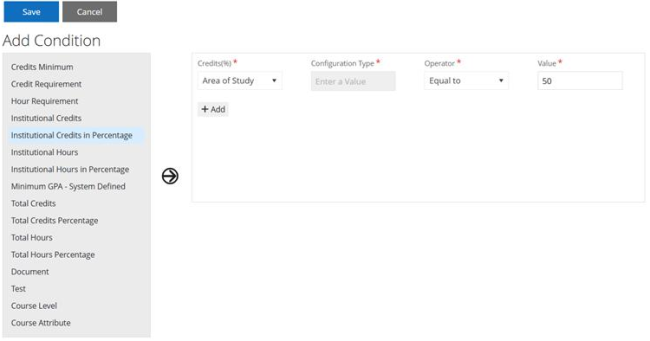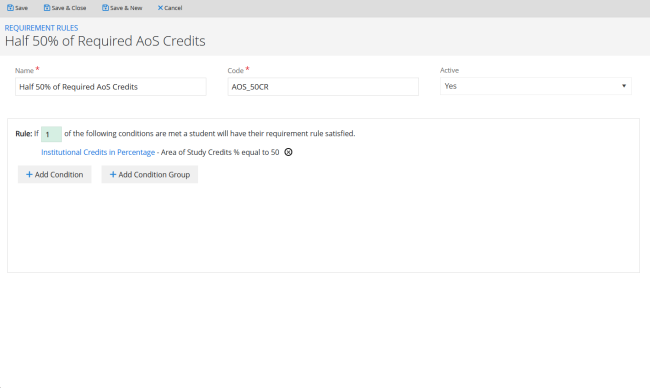Background for Requirement Rules
You can configure and then assign requirement rules. For example, to meet degree requirements you can configure requirement rules that require students to:
-
Complete a certain number of credits or hours
-
Complete a certain number of hours of a specific course level
-
Take a certain number of credits or hours at your institution
-
Maintain a specific GPA
Some requirement rules also result in a message for advisors and students when they are about to register for a course that does not satisfy a requirement rule.
How Anthology Student Performs the Evaluation
Anthology Student evaluates using the requirement rule at the assigned level. For example, if you create a requirement rule that requires 12 credits of level 300-400 level courses and assign the requirement rule to:
-
An area of study, the student meets the requirement when they complete 12 credits by taking any 300 or 400 level courses in the course list for that area of study
-
An area of study category level of a catalog, the student meets the requirement when they complete 12 credits by taking 300 or 400 level courses in that category
Anthology Student evaluates the rules independently. In this example, you create:
-
A requirement rule that requires 12 credits of level 400 courses and assign it to an area of study
- Another requirement rule that requires 45 credits and assign select it to a program version
If the student earns 12 credits in the level 400 courses:
- They meet the requirement for the area of study
-
Anthology Student applies the same 12 credits towards the program version requirement of 45 leaving the student with 33 required credits remaining
Where You Can Assign Requirements Rules
The table shows the levels where the requirement rules you can configure can be assigned.
| Level | Where Selected During Configuration |
|---|---|
| Program | Select the Configuration tile > expand Academic Records > select Programs. |
| Program version | Select the Configuration tile > locate Academic Records > select Programs > select the name of the program in the list > select the New button and specify the general information or select an existing program version > select the Requirement Rules tile. |
| Program version category level of a catalog | |
| Program version category level of a catalog for an elective or substitution pool |
|
| Area of study | Select the Configuration tile > locate Academic Records > select Area of Study >select the New button and specify the general information or select an existing area of study name in the list > select the Requirement Rules tile. |
| Area of study category level of a catalog | |
| Area of study category level of a catalog for an elective or substitution pool |
Requirement Rules and Student Enrollment
When you enroll a student in a program version and any areas of study, Anthology Student adds the courses and requirement rules configured for the program version and areas of study to their enrollment and displays the courses on their:
-
Course list (Select the Students tile > select the name in the Students list > expand Academic Records > select the Student Courses tile.)
-
Degree progress audit (Select the Students tile > select the name in the Students list > expand Academic Records > select the Degree Progress Audit tile.)
- If a template is configured, their degree pathway (Select the Students tile > select the name in the Students list > expand Academic Records > select the Degree Pathway tile.)
Requirement Rules and Degree Progress Audit
You can use the degree progress audit to make sure that students satisfy the requirements outlined in the requirement rules. On the Requirement Rules tab on the student Degree Progress Audit page you can review:
-
All the requirement rules at all the levels
-
The courses required for those rules and the courses applied
-
The credits or hours required for those rules and the credits or hours earned
If more courses are taken than are needed to satisfy a rule, the column displays only the courses that satisfy requirement rules.
Requirement Rules and Degree Pathway and Portal
If an Advisor or student tries to register from their Degree Pathway page or from Portal and there are requirement rules for an elective pool, Anthology Student displays a message when they are about to register for a course that does not satisfy a requirement rule.
For example, if there is a requirement rule that specifies a maximum of 24 credits from an elective pool, Anthology Student displays a message if the student has already completed the 24 credits. The message does not prevent you from registering the student.
Types of Requirement Rules
The requirements you can use in rules are flexible and can be tailored to meet the requirements at your institution.
For example, you can configure requirements rules using these characteristics that are also configured by your institution and then selected for the courses.
-
Attributes (Select the Configuration tile > locate Academic Records > select Course Attributes.)
-
Course Codes (Select the Configuration tile > expand Academic Records > select Courses.)
-
Course Groups (Select the Configuration tile > locate Academic Records > select Course Groups.)
-
Levels (Select the Configuration tile > locate Academic Records > select Course Levels.)
-
Prefixes (Select the Configuration tile > locate Academic Records > select Course Prefixes.)
-
Types (Select the Configuration tile > locate Academic Records > select Course Types.)
When you configure requirement rules, you can select from the following types.
-
Standard
-
Advanced - Course Levels and Course Attributes
-
Advanced - Rule Based
-
Test
-
Document
If you want to select the Advanced – Rule Based in the Type list for requirement rules in version 21.1 or later to specify more complex requirements, your institution must have selected Yes for Enable Rule Based Requirement Rules and Levels![]() when it configured advanced features in the system settings for Anthology Student.
when it configured advanced features in the system settings for Anthology Student.
Use the table to determine the types of requirement rules to select.
| Minimum You Want to Specify | Additional Requirements You Can Add | Type of Requirement Rule to Select |
|---|---|---|
| Number of credits or hours and/or courses | None | Standard |
| Document required for the completion of the program | Document Status | Document |
| Tests required for completion of the program |
Numeric, Text, Date Value, Minimum Score Note: A new test score record is added to a student record. This satisfies requirement rule if a minimum score is not entered in the requirement rule. |
Test |
| Number of credits or hours |
You can select by name:
|
Advanced - Course Levels and Course Attributes |
| Number of credits or hours using the pass or fail setting for the course |
You can specify more complex requirements using operators with any or all of the characters you specify in the code for:
For institutional, you can also require courses from specific class sections. |
Advanced - Rule Based |
| Number of the total credits or a percentage of the total for an enrollment or area of study | ||
| Number of the total hours or a percentage of the total for an enrollment | ||
| Number or percentage of the credits for an area of study that must be taken at your institution (Institutional requirements are also referred to as residency requirements or residency credits). | ||
| Number or percentage of the hours for an enrollment that must be taken at your institution (institutional). | ||
| Type of GPA (such as minimum GPA for the enrollment or course level). | None |
Example for Type Standard
For example, you can create a requirement rule for programs that requires 120 credits and 40 courses.
Example for Type Document
For example, you can create a requirement rule for programs that require a thesis document in order to graduate. Another example is requiring a portfolio.
Example for Type Test
For example, you can create a requirement rule for programs that require a subject specific test/ comprehensive exam to satisfy a graduation requirement. If there is a minimum required score, that score must be met for the requirement rule to be fulfilled. If a minimum score is not specified in the requirement rule, then as soon as the test result is posted it will be fulfilled.
Example for Type Advanced - Course Levels and Course Attributes
The table provides some examples of requirement rules that you could implement using the type Advanced - Course Levels and Course Attributes. The same or similar requirement rules could also be specified for areas of study and their levels.
| Level | Example Requirement Rule |
|---|---|
| Program version |
Requires:
|
| Program version category level of a catalog |
Requires:
|
| Program version category level of a catalog for an elective or substitution pool |
Requires 6 credits from courses configured with both of these attributes:
|
Rules for Type Advanced - Rule Based
When you select Advanced - Rule Based, you also select one of these rules.
| Minimum You Want to Specify | Rule to Select |
|---|---|
| Number of credits or hours using the pass or fail setting for the course | Credit Requirement |
| Hour Requirement | |
| Number of the total credits or a percentage of the total for an enrollment or area of study | Total Credits |
| Total Credits in Percentage | |
| Number of the total hours or a percentage of the total for an enrollment | Total Hours |
| Total Hours in Percentage | |
| Number or percentage of the credits for an area of study that must be taken at your institution (institutional). | Institutional Credits |
| Institutional Credits in Percentage | |
| Number or percentage of the hours for an enrollment that must be taken at your institution (institutional). | Institutional Hours |
| Institutional Hours in Percentage | |
| Type of GPA (such as minimum GPA for the enrollment or course level). | Minimum GPA - System Defined |
Examples for Type Advanced - Rule Based
The table shows some examples for the system defined rules. It shows the levels where you can select the requirement rule, the rule, and an example. Most examples for credits can also be used for hours.
| Example Selected Level | Example Requirement Rule | Example Rule to Select |
|---|---|---|
| Program | Require a minimum of 120 credits for a degree | Total Credits |
|
Program version |
Require that 18 credits be completed at your institution. | Institutional Credits |
| Require a minimum of 2.0 GPA. | Minimum GPA - System Defined | |
| Require the number of required credits configured for the program version. | Total Credits | |
| Program version category level of a catalog | Specify a maximum of 24 credits from an elective pool. | Credit Requirement |
| Program version category level of a catalog for an elective pool | Specify a maximum of 18 credits in pass or fail courses. | Credit Requirement |
| Area of study | Require the number of required credits configured for the area of study. | Total Credits |
| Require a minimum of 2.0 GPA. | Minimum GPA - System Defined | |
| For a major require that 50% of the credits be completed at your institution. | Institutional Credits in Percentage | |
| Area of study category level of a catalog | Require 6 credits of 300-499 level courses with the attribute of writing intensive. | Credit Requirement |
| Area of study category level of a catalog for an elective pool | Require that 6 credits be completed at your institution. | Institutional Credits |
Examples for Type Advanced - Rule Based
The table provides an overview of the examples.
| Example Selected Level | Example Requirement Rule | Example Rule to Select |
|---|---|---|
| Program | Require a minimum of 120 credits for a degree | Total Credits |
| Program version | Require a minimum of 2.0 GPA. | Minimum GPA - System Defined |
| Program version category level of a catalog | Specify a maximum of 24 credits from an elective pool. | Credit Requirement |
| Program version category level of a catalog for an elective pool | Specify a maximum of 18 credits in pass or fail courses. | Credit Requirement |
| Area of study | For a major require that 50% of the credits be completed at your institution. | Institutional Credits in Percentage |
The following example shows a requirement rule applied to the program that requires a minimum of 120 credits.

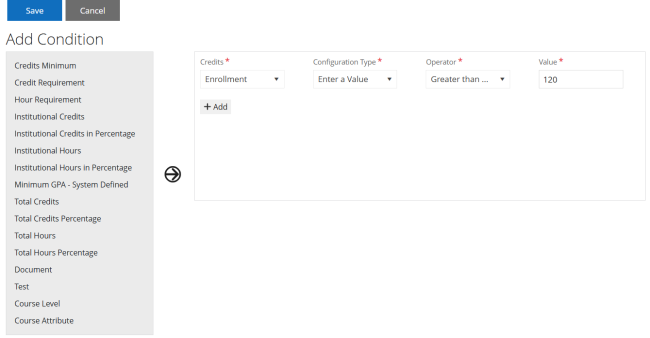
The following example shows a requirement rule that is applied to a program version that requires a minimum of a 2.0 grade point average (GPA).

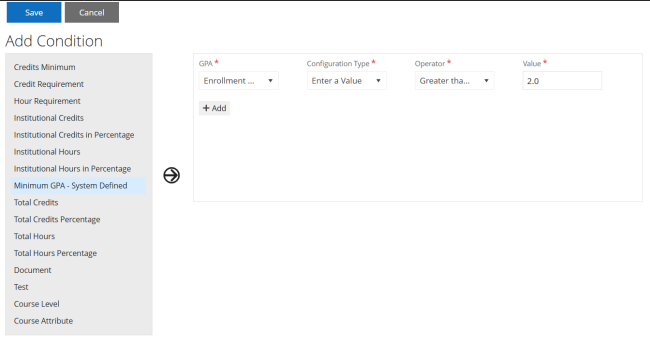
The following example shows a requirement rule applied to the program version category level of a catalog that specifies a maximum of 24 credits from an elective pool.

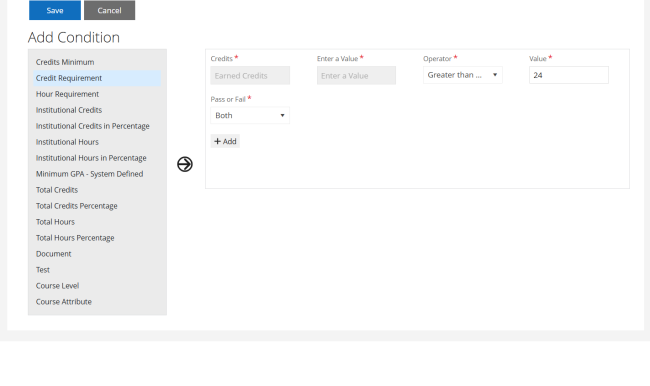
The following example shows a requirement applied to the program version category level of a catalog for an elective pool that specifies a maximum of 18 credits from pass or fail courses.
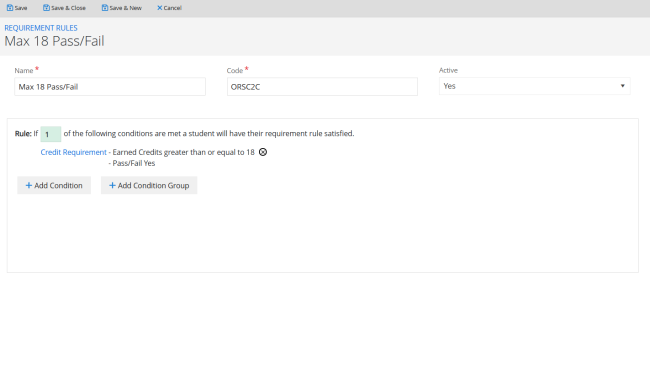
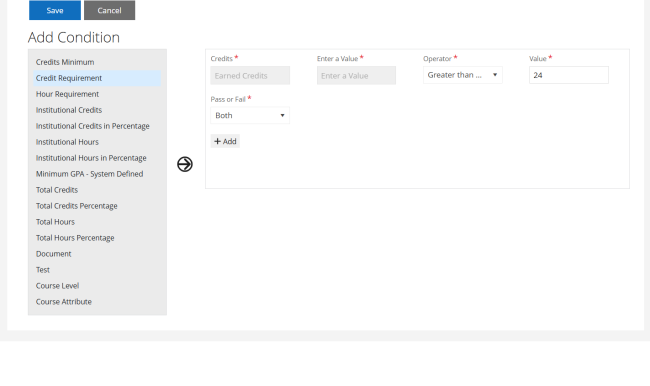
The following example shows a requirement rule that requires half of the credits for an area of study major be completed at your institution.
